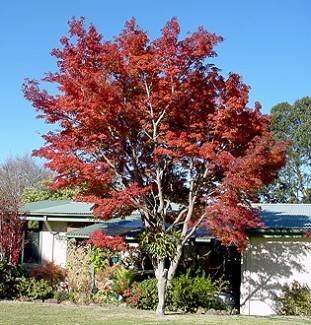Acer palmatum |
| PlantFile Report |
Copyright © 2000 - 2025 Peter Kirkland - www.plantfile.com |
Plant Profile |
|
| Plant |
| ID |
|
321 |
 |
| Botanic Name |
|
Acer palmatum |
| Common Name |
|
Japanese Maple |
| Family Name |
|
Sapindaceae |
| Cultivars |
|
'Albomarginatum','Atropurpureum','Aureum','Emperor 1','Hessei','Nishiki-gawa','Sango kaku','Trompenburg','Crimson Queen','Dissectum atropurpureum','Roseum marginatum','Elegans','Red Pygmy','Rubrum','Villa Taranto''Koto N |
| Origin |
|
Japan, 1820, Zone 5-10 |
| Growth Type |
|
Tree |
| Bark Type |
|
Fissured or Wrinkled |
| Foliage Type |
|
Deciduous |
Water Use |
|
Medium |
| No. of Species |
|
36 |
| Growth Habit |
|
Broad domed |
Growth Rate |
|
Slow |
| Height |
|
4 - 5 m (13 - 17 ft) |
Spread |
|
4 m (13 ft) |
| Plant Overview |
|
This small deciduous tree has a solitary or multiple trunks with upright spreading branches that form a rounded crown. It has lobed mid green leaves that turn reddish during autumn and the small red saucer-shaped flowers appear in a pendant cluster in spring. |
|
| Leaf |
| Type |
|
Simple |
|
Additional Information |
| Shape |
|
Palmately lobed |
|
The palmately leaves have 5, 7 or 9 acuminate lobes and the margin is incised (biserrate) and are up to 120 mm (4 ¾ in) long with a slender petiole to 40 mm (1 5/8 in) long. During late autumn the leaves turn red, orange or yellow. |
| Arrangement |
|
Decussate |
| Margin |
|
Serrate |
| Colour |
|
Mid green |
| Size |
|
60 - 120 mm ( 2.4 - 4.7 in ) |
|
| Flower |
| Perfume |
|
Odorless |
|
Additional Information |
| Shape |
|
Crateriform |
|
The unisexual crateriform flowers have 5 sepals and 5 petals with 4 - 10 stamens and are arranged in a pendulous corymb or umbel that appears with new foliage during spring. |
| Inflorescence |
|
Corymb |
| Colour |
|
Red |
| Size |
|
3 - 6 mm ( 0.1 - 0.2 in ) |
|
Flowering in (Southern Hemisphere)
|
|
| Jan |
Feb |
Mar |
Apr |
May |
Jun |
| Jul |
Aug |
Sep |
Oct |
Nov |
Dec |
|
|
| Fruit |
| Type |
|
Samara |
|
Additional Information |
| Colour |
|
Light brown |
|
The light brown twin samara is joined at the base and has membranous wings and are up to 38 mm (1 ½ in) wide. They appear in small weeping clusters on the end of branches during autumn. The seeds are viable, the plant may be reproduced vegetatively. |
| Edible |
|
No |
| Bird Attractive |
|
Yes |
| Size |
|
12 - 38 mm ( 0.5 - 1.5 in ) |
|
Fruiting in (Southern Hemisphere)
|
|
| Jan |
Feb |
Mar |
Apr |
May |
Jun |
| Jul |
Aug |
Sep |
Oct |
Nov |
Dec |
|
|
| Environment & Cultivation |
| Natural Soil |
|
Well drained but moist sandy to light clay loam, organic rich, pH 4.5-7.0 |
| Container |
|
Tubs, large pots, planter box, protected roof gardens, bonsai subject |
| Climate |
|
Cold - cool temperate |
| Aspect |
|
Full sun-semi shade, wind protected, drought tender, frost-cold tolerant |
| Pest & Diseases |
|
Leaf burn during hot wind, borers during stress, aphids on new growth |
| Fertiliser |
|
Mulch during summer and keep moist, apply complete fertiliser during late winter |
| Pruning |
|
Only as necessary, train to a single leader for a tree habit, remove dead or damaged wood |
| Cultural Uses |
|
Propagation |
|
The Japanese Maple is grown for spreading crown and its autumn foliage. It is planted in parks and gardens as a lawn specimen or along avenues for shade and autumn colour. It is suitable for mountain or coastal regions, establishes in 4 to 10 years.
|
|
Sow fresh seed during spring and the seedlings may be used as rootstock for grafting or budding from winter to early spring. Plants may be transplanted during the dormant period. |
|
|